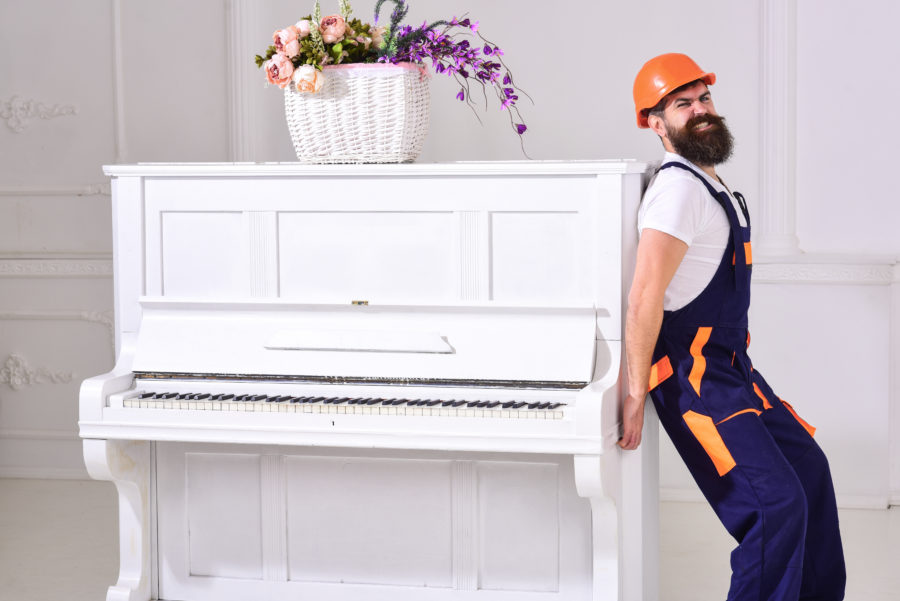
Detailed Guide on How to Move a Piano
Understanding how to move a piano is one of the trickiest bits when it comes to relocating for most people. Apart from having 88 keys, the instrument usually contains thousands of components, and the disassembling and handling process differs based on the make and model of the instrument. Taking enough time to do this properly is vital, and you need to be aware of all the potential risks in order to prevent any damage or injury.
Pianos are hard to transport for more reasons than one. First of all, they are heavy, and you need to know exactly how to carry them to prevent putting the load on your body. On the other hand, they require special equipment if you want the process to run smoothly and your instrument to survive the transition. Lastly, due to their weight and size, these instruments usually need specially planned out routes because they really can’t pass through any door. Read on to find out how best to prepare and approach this complex task.
Moving a Piano Yourself Is Possible With Our 4-Step Guide
You should know upfront that learning how to move a piano yourself is possible, but it requires patience and thorough planning. Every mistake in this process can cause serious consequences, so taking your time definitely pays off. You should decide in advance what your type of instrument requires, what equipment you’ll use, how you’ll approach the space, and how many helpers you want. This is not a job for one, so start searching for people to have at your beck and call as soon as possible. This being said, let’s dig into details.
Knowing the Type of Your Instrument
Pianos come in different sizes, and they differ by many criteria. Still, the easiest distinction is between grand pianos that are the bulkiest ones, usually used in concert halls, and the upright ones, that most people usually have in their home. Knowing what category your instrument falls under is vital because it will help you decide what equipment to look for.
Equipment and Moving Supplies You Need
As they say, knowing what to do is one thing, but having the right tools to get the job done is another! The kind of instrument will determine the right equipment, but taking care of this aspect on time is crucial. So, what will you be needing?
- Dollies – These are a must if you want to do this successfully. Their rubber wheels don’t scratch your floors, and if you put the instrument on these properly, you did the hardest bit.
- Board – This tool is great, but if you buy a board with no wheels, you’ll have to use the dolly once the instrument is put on it and securely tied.
- Strapping – In order to adjust the weight and safely move your instrument, the right straps are paramount. Try searching for locking straps or those with ratchets to help you tighten the instrument and prevent any unwanted shaking. Besides, you can look for hump straps that are designed to extend the use of your arms and ideal if you are climbing the stairs with the instrument.
- Blankets or pads – These serve to protect your instrument, especially its edge upon lifting.
- Shoulder harness – This mechanism helps people to properly use their shoulders and legs while they are lifting heavy weights. It doesn’t add to the weight you can carry, but it can go a long way in preventing injuries from happening.
- Stair ramp – If you have stairs that are problematic, or you simply want to facilitate this bit, this ramp is great. It can support a lot of weight, and it makes your passage down or up the stairs with the instrument much easier.
Make a Plan for Your Route
After obtaining all the equipment, you should sit and think about what’s the best strategy to get around your home with the big load you’ll be carrying. This means that if there are multiple roads you can take, you should go for the easiest one. But, more importantly, you must get furniture that’s bulky and would be an obstacle out of the way. Though it might seem redundant, it’s actually what will determine your future success and reduce the moving stress.
Don’t Go It Alone
Your helpers have to be aware of what you have in mind for the big day, and you have to agree with them on the strategy. Needless to say, once you start with the project, you must listen to the people you chose to assist you because if you don’t, things might unfold in unwanted ways.

What Is the Easiest Way to Move a Piano by Type?
Not all types are transported in the same way. As we mentioned above, the type determines the procedure, so knowing how to move upright piano is different from knowing the details for moving a grand piano. If you figured out which one you’ve got, your next step is to learn what that means for your process.
How to Move an Upright Piano?
These are smaller in size than their concert counterparts, and because of this, slightly easier to transport. You should first wrap the piano’s lid and tape it shut to avoid it opening during your move. After this, wrap the pedals and secure them with tape as well. In the end, if you want to be on the safe side, cover all sides of the instrument with protective wrap and secure it with tape too. This is vital because, in the truck, there can also be some wood or metal accidentally scratching the instrument. After your instrument is ready, attach it to the strapping you chose. Once this preparation is complete, you’re ready to put it on the dolly. Finally, it’s vital to remember not to disassemble any components you’re not sure how to put back later because that will do more harm than good when moving an upright piano.
How to Move a Grand Piano?
The process that applies for this type is similar to the one used for upright ones, but you should keep in mind that almost all of these require disassembling. Use a screwdriver to take off the pedals and legs and then protect the body of the instrument. Concert ones are not all the same weight, so make sure you choose the right dolly and straps that can support your instrument.

The Don’ts of Moving a Piano by Yourself
As you have probably realized by now, you can do this on your own, but it is quite risky, and you must be on the ball all the time. Since we covered the best ways to approach this, it is time for some mistakes to be avoided if you decide to persist in DIY:
- Don’t forget to measure your instrument – Though it is not an easy task, it is utterly necessary because, without this info, you won’t be able to find the right equipment. Go to the website of your producer, and you might find the info you’re after there or in the specifications usually packed with the instrument. You can get some guidelines on average piano weight online too.
- Under no circumstances try to go solo – This is a dangerous endeavor, and the tiniest mistake can cost a lot. Thus, let your friends or family members know on time you’ll be needing them for this task and find something to compensate for their efforts.
- Don’t rely too much on casters and rollers already on it – Now, this depends on the particular one you’ve got, but these can be weak or scratch your floors and tear the carpets. Most failed attempts happened precisely due to reliance on these. If, however you decide to use them, you must come up with how you’ll test them first.
- Don’t hurry – As they say, move in haste, repent at leisure. But, seriously, this is not a task where being quick counts, and you have all the time in the world to get it done safely and properly.
Can You Lay a Piano Down to Move It?
Though this method is possible, it’s got more cons than pros. The keyboard instrument is a delicate and fragile mechanism, and all components work together, so if you put too much pressure on the wrong place, you’re making more than one problem. It’s much better to try and tilt the instrument a little bit backwards if possible and lift it on both sides with the help of at least one more person. Besides, this position is to be avoided during transportation as well because pianos can get damaged like this if there are any bumps on the road.

How to Move a Piano Up or Down the Stairs?
Most people dread the stairs because that’s where the majority of accidents take place. And it is true; you should be extra careful with these, plan your strategy, and plan B in advance. And how to do these? If you are climbing up, ensure one person is pushing at the bottom and one pulling at the top. The person pulling should elevate the instrument while the person at the bottom is holding the body of the instrument, not the handles. If you are going down, the process is reversed. Besides, if something goes awry, never ever try to save the instrument because you can get severely injured. So, plan B is you and your helpers always come first. Take a look at the following video if you’d like to see how to make a skid for the stairs.
Don’t Forget That Getting Help From Professional Cross Country Movers Is Also an Option
Amidst all the hustle and bustle, while you’re trying to figure out how to deal with moving to a new city alone or moving out for the first time budget, hiring a reputable cross country moving company can save you a lot of time and nerves. Apart from the fact that professional cross country movers can provide you with efficient packing services, auto transport, storage, and moving services, they are also trained and experienced in matters such as this one. This means that if you opt for these, you can be completely calm in knowing your instrument will be transported safely to your new home or storage if you prefer it that way.
How Much Does It Cost to Move a Piano Professionally? Read More Than One Offer
Most people are interested in the price of relocation services. However, it is not possible to pluck a number out of the air because cross country moving companies usually form an overall price, which is the sum of all services you chose to get. Besides, the weight of your instrument, as well as its type and the difficulties involved in the route, will all affect the final price. However, you are not to be kept in the dark until the grand moment when the price will be revealed. The good thing is that all professional cross country movers have impeccable customer service, which will be able to give you a quote or estimate as soon as you call and let them in on the details.

The Best Way to Move a Piano
What you’ll go for when transporting your instrument will ultimately depend on your confidence, relocating experience, and many other personal factors. Learning various moving hacks gets you a step closer to getting the job done as you’d like it, but needless to say, hiring a cross country moving company with stellar reviews is the safest route. With all the other tasks and stress, there’s simply not always enough time to dedicate to your instrument, and risking here can lead to terrible results.